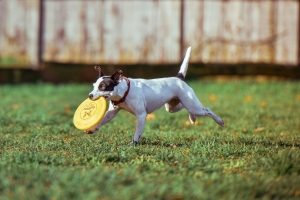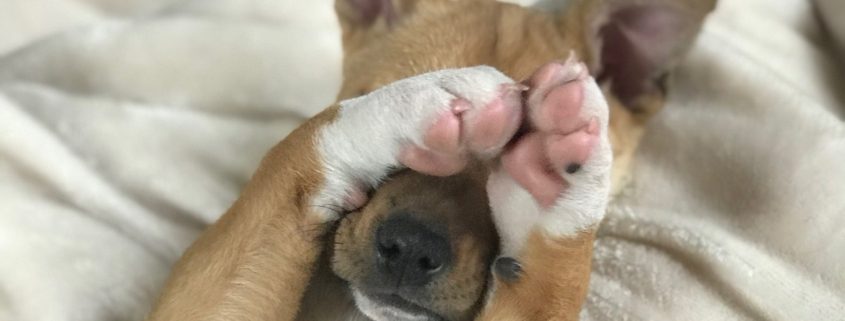Ask Crystal: Fireworks Derail Nightly Routine
Welcome to “Ask Crystal,” where you can ask your pet behavior questions! You can submit your question for Crystal at the bottom of the page!

Dear Crystal,
I took my dog into the garden for her nightly wee a couple of times recently when I mistakenly thought fireworks had finished for that night. She was terrified and now refuses to wee at night for me.
A neighbor walks her every morning and if he comes down at night, she immediately does what she knows is expected of her.
How can I build her trust in me again and get her to do the necessary?
Sincerely,
Fireworks are Scary
Dear Fireworks,
I actually had the exact same problem with my new dog after the 4th of July. She was already on edge from the fireworks and then a neighbor across the street started target practice while we were outside playing. She ran into the house terrified and hid in the closet, which she had never done. After that she would not go outside at night for about 3 weeks.
Management for this issue should start by working to avoid sources of stress for your dog. This incident was traumatic for her and she is now likely on the threshold of her stress tolerance. We refer to it as trigger stacking when a number of stressors build up. The dog will be more reactive and fearful of not only known fears but they can become more reactive to things that they can normally tolerate. Try to keep her life really quiet for the next few weeks with very little outings or visitors. This will help bring her stress hormones down to a more manageable level.
You may consider some tools to help with her anxiety during this period. You can also use them during times when you know there will be fireworks and storms. Different things will work for different dogs and you may need a combination of tools. Anxiety wraps like a Thundershirt can help calm dogs down, especially if the dog likes being held. You may try some holistic remedies if you like a more natural approach. Suntheanine is a brand of L-theanine which is an amino acid in tea which there have been studies to indicate it can be therapeutic for anxiety in dogs. BlackWing Farms sells flower essence sprays for trauma called Trauma Drama. Purina Calming Care has a strain of probiotics BL999 which has been shown to help keep dogs calm and helps them cope with external stressors. There are many products marketed for anxiety for dogs.
At this point, avoid taking her outside at night in the garden. Take her outside before it gets dark. If she is willing to go with your friend at night, you can have him come and take her out. A couple things could be going on with why she will go with him and not you at night. He may be taking her out a different route. For example, this happened while you were in the backyard with her. If he takes her out for a walk that is a different environment and a walk is different than being loose in the backyard. Dogs are not great at generalizing so she may not associate him or the route he takes with the fireworks.
If you normally let her out back to the yard, try a different exit and potty area at night. Instead take her on leash out the front door or through the garage and walk her in the front yard. You could try to have your neighbor come over and see if she wants to go to the garden with him. If so, maybe spend some sessions where all of you go out there together. He could even hand her over to you to walk her. Or you could see if she might play with you while he is out there with you.
I really like the fact that you said you want to gain her trust. Even though the issue itself is likely not caused by a distrust in you, how we deal with it can cause distrust. That means being able to read your dog’s body language and to not force her to do things that are making her uncomfortable.
We want to avoid flooding, which is a technique that tries to force a dog to face its fears by forcing them outside. We also don’t want to pick her up and put her outside as that still leaves her outside where she is scared. Likewise, we don’t want to drag her out or lure her out with food. It needs to be her idea to go outside. We also want to be sure that we are not punishing the dog by getting frustrated and yelling at them. Instead, try a jolly routine of using a happy upbeat tone when our dogs are showing fearful behavior.
The reason that we do not want to use flooding is because when a dog is in a fearful state, they are unable to learn. The cerebral cortex is the dog’s thought center. This is the part of the brain that produces learning, memory, attention and problem solving. The limbic system is the emotional part of the dog’s brain. When one brain system in in use, the other’s function is inhibited. Therefore, if a dog is feeling afraid, she will be unable to learn or problem solve. When the dog is in that state, all we can do is remove them from the situation if possible and work on a training protocol outside of the fear inducing situation.
 During the day, work on creating a positive association with the garden. We want to start at a time which does not provoke fear. As you work through the exercises, start playing the games with her at dusk before it gets dark and later and later as she is able to tolerate it. If she is still playing, then she is feeling good. Play and fear are mutually exclusive in dogs so she won’t be playing if she is feeling afraid so it’s a good way to gauge her emotions.
During the day, work on creating a positive association with the garden. We want to start at a time which does not provoke fear. As you work through the exercises, start playing the games with her at dusk before it gets dark and later and later as she is able to tolerate it. If she is still playing, then she is feeling good. Play and fear are mutually exclusive in dogs so she won’t be playing if she is feeling afraid so it’s a good way to gauge her emotions.
Have several short play sessions throughout the day in the yard. Stand outside with her favorite squeaky toy or ball and toss it around. Use a flirt pole to have her chase around the yard.
Play training games in the yard throughout the day. Play scatter games with her kibble in the grass. Toss some kibble in the grass and tell her “find it” and then run off so she chases you and repeat. Play hide and go seek in the garden if there are areas to hide behind. Train her for some of her meals in the garden.
Have a treat trail starting at the door and leading to the garden with a high value treat at the end like her favorite chewy. Do this at random times during the day. Hide a toy, chews or treats for her to find in the yard.
Create a feeding station by the back door and let her eat by the door with the door closed and work up to the door being open if possible. As she gains comfort, place the bowl on the threshold of the door. Eventually you should be able to feed on the outside of the door and move the bow away from the door.
Provided that there are no further incidents and you don’t force her outside at night, she may just get over this with some time. My own dog started going out with us after 3 weeks and we have slowly been working on her going outside by herself at night. It really depends on the dog’s personality, stress levels and if we can keep her from experiencing it again for a while, at least.
I would suggest that you also start working on a desensitizing and counterconditioning protocol for fireworks now while hopefully there won’t be any for a while. Victoria Stillwell has a CD that has a protocol on it for working on firework phobias. It works by pairing low levels of firework noises with food to change the dog’s emotions. There is also another article on our website which goes into further details about working with firework phobias. You may never get rid of that fear but you may be able to lessen it so that it is manageable. Have hope and stay positive!
Until next time,
Crystal







